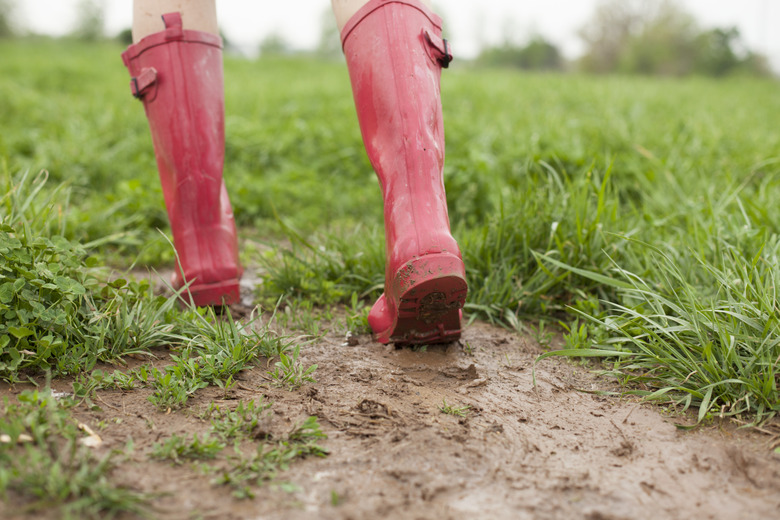How To Fix A Muddy Lawn
Neglect can turn a lawn muddy over time, or the problem could be more serious. Soil compaction, turf grass that doesn't tolerate shade, poor drainage and bad grading can all cause a muddy lawn. To save time and effort, find out what's causing the problem before attempting a fix. Mowing, fertilizing and raking a lawn regularly when it's growing strongly again help prevent the problem from returning.
Relieving Compaction
Aeration fixes compacted soil in a muddy lawn and removes thatch. Lawn traffic squeezes the air out of soil over time, preventing water from penetrating, and water also drains poorly through thatch thicker than 1/2 inch. Thatch is dead grass and other plant debris. To check whether soil is compacted, dig out a section 1 foot square and 6 inches deep and look at the grass roots. Roots extending only 1 or 2 inches deep indicate compacted soil. Aerate a lawn when soil is moist but not sodden. Mark sprinkler lines and heads, cables and any other vulnerable lines, and run a machine aerator over the lawn in both directions, removing plugs every 2 inches. Aerate cool-season grasses in late summer and warm-season grasses in midsummer.
Reseeding With Shade-Tolerant Grass
Shade can cause a muddy lawn when turf grass grows poorly. Several grasses tolerate shade, such as creeping red fescue (Festuca rubra), which is a cool-season grass that grows in U.S. Department of Agriculture plant hardiness zones 3 through 7, and St. Augustine grass (Stenotaphrum secundatum), a warm-season grass that grows best in USDA zones 8 through 10. Reseeding can take place after aerating a lawn or removing thatch by raking it out. Spread the grass seed at the recommended rate, such as 3 to 5 pounds per 1,000 square feet for creeping red fescue, and 1/2 to 1 pound per 1,000 square feet for St. Augustine grass. Cover the seed 1/4 to 1/2 inch deep with fine soil, and water thoroughly, applying water again when the soil is dry to a depth of 1 inch.
Installing Drainage
Heavy clay or impermeable subsoil can cause a muddy lawn, but installing drainage can correct the problem. Clay soil becomes waterlogged easily, and impermeable subsoil prevents water from draining freely. To check whether your soil or subsoil drains poorly, dig a hole 1 foot deep and fill it with water. Poorly drained soils will retain the water for longer than 30 minutes. Install a French drain to provide an outlet for water from your lawn. Dig a channel 1 foot deep and wide through the area of lawn that suffers worst from muddiness, with the trench leading toward a water outlet, such as a ditch, pond or rain garden, and fill the channel with gravel or small rocks to prevent the sides from collapsing.
Removing and Regrading
Water can't escape a badly graded lawn, which causes muddiness. A lawn should slope slightly toward the street or another outlet for water. A badly graded lawn slopes to an area where water cannot escape, such as a house or hill, or contains hollows where water pools. A muddy lawn caused by bad grading can only be fixed by removing the grass, regrading, and seeding or laying another lawn. Remove the grass by digging it up. Till the soil to a depth of 6 inches, mixing in 1 inch of compost or another fine organic matter if the soil is clayey or sandy, and rake the soil so that it slopes at a rate of 4 feet per 100 feet toward the street, driveway or another water outlet. Rake the soil surface until it's fine and crumbly, and compact it lightly with a lawn roller before sowing seed, planting sprigs or laying sod.
References
- Colorado State University Extension: Soil Drainage
- Virginia Cooperative Extension: Aerating Your Lawn
- University of California Statewide Integrated Pest Management Program: Turfgrass
- Clemson Cooperative Extension: Lawn Renovation
- Seedland: Climate Maps, Grass Type Chart & More
- Penn State College of Agricultural Sciences: Establishing a New Lawn
- University of California Sonoma County Master Gardeners: Grass Removal Methods
